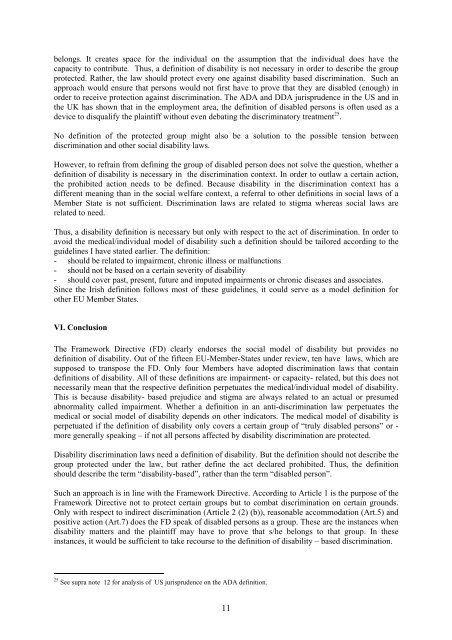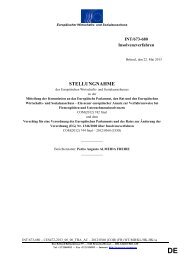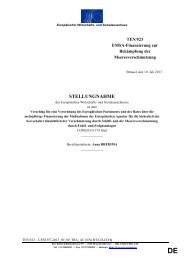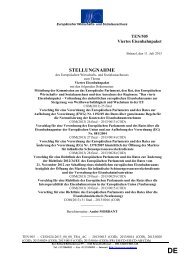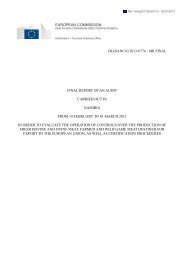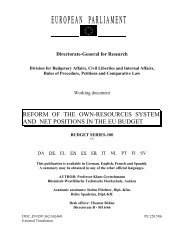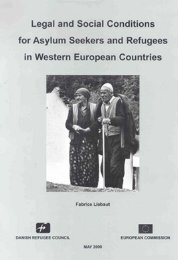Definition of disability
Definition of disability
Definition of disability
You also want an ePaper? Increase the reach of your titles
YUMPU automatically turns print PDFs into web optimized ePapers that Google loves.
elongs. It creates space for the individual on the assumption that the individual does have the<br />
capacity to contribute. Thus, a definition <strong>of</strong> <strong>disability</strong> is not necessary in order to describe the group<br />
protected. Rather, the law should protect every one against <strong>disability</strong> based discrimination. Such an<br />
approach would ensure that persons would not first have to prove that they are disabled (enough) in<br />
order to receive protection against discrimination. The ADA and DDA jurisprudence in the US and in<br />
the UK has shown that in the employment area, the definition <strong>of</strong> disabled persons is <strong>of</strong>ten used as a<br />
device to disqualify the plaintiff without even debating the discriminatory treatment 25 .<br />
No definition <strong>of</strong> the protected group might also be a solution to the possible tension between<br />
discrimination and other social <strong>disability</strong> laws.<br />
However, to refrain from defining the group <strong>of</strong> disabled person does not solve the question, whether a<br />
definition <strong>of</strong> <strong>disability</strong> is necessary in the discrimination context. In order to outlaw a certain action,<br />
the prohibited action needs to be defined. Because <strong>disability</strong> in the discrimination context has a<br />
different meaning than in the social welfare context, a referral to other definitions in social laws <strong>of</strong> a<br />
Member State is not sufficient. Discrimination laws are related to stigma whereas social laws are<br />
related to need.<br />
Thus, a <strong>disability</strong> definition is necessary but only with respect to the act <strong>of</strong> discrimination. In order to<br />
avoid the medical/individual model <strong>of</strong> <strong>disability</strong> such a definition should be tailored according to the<br />
guidelines I have stated earlier. The definition:<br />
- should be related to impairment, chronic illness or malfunctions<br />
- should not be based on a certain severity <strong>of</strong> <strong>disability</strong><br />
- should cover past, present, future and imputed impairments or chronic diseases and associates.<br />
Since the Irish definition follows most <strong>of</strong> these guidelines, it could serve as a model definition for<br />
other EU Member States.<br />
VI. Conclusion<br />
The Framework Directive (FD) clearly endorses the social model <strong>of</strong> <strong>disability</strong> but provides no<br />
definition <strong>of</strong> <strong>disability</strong>. Out <strong>of</strong> the fifteen EU-Member-States under review, ten have laws, which are<br />
supposed to transpose the FD. Only four Members have adopted discrimination laws that contain<br />
definitions <strong>of</strong> <strong>disability</strong>. All <strong>of</strong> these definitions are impairment- or capacity- related, but this does not<br />
necessarily mean that the respective definition perpetuates the medical/individual model <strong>of</strong> <strong>disability</strong>.<br />
This is because <strong>disability</strong>- based prejudice and stigma are always related to an actual or presumed<br />
abnormality called impairment. Whether a definition in an anti-discrimination law perpetuates the<br />
medical or social model <strong>of</strong> <strong>disability</strong> depends on other indicators. The medical model <strong>of</strong> <strong>disability</strong> is<br />
perpetuated if the definition <strong>of</strong> <strong>disability</strong> only covers a certain group <strong>of</strong> “truly disabled persons” or -<br />
more generally speaking – if not all persons affected by <strong>disability</strong> discrimination are protected.<br />
Disability discrimination laws need a definition <strong>of</strong> <strong>disability</strong>. But the definition should not describe the<br />
group protected under the law, but rather define the act declared prohibited. Thus, the definition<br />
should describe the term “<strong>disability</strong>-based”, rather than the term “disabled person”.<br />
Such an approach is in line with the Framework Directive. According to Article 1 is the purpose <strong>of</strong> the<br />
Framework Directive not to protect certain groups but to combat discrimination on certain grounds.<br />
Only with respect to indirect discrimination (Article 2 (2) (b)), reasonable accommodation (Art.5) and<br />
positive action (Art.7) does the FD speak <strong>of</strong> disabled persons as a group. These are the instances when<br />
<strong>disability</strong> matters and the plaintiff may have to prove that s/he belongs to that group. In these<br />
instances, it would be sufficient to take recourse to the definition <strong>of</strong> <strong>disability</strong> – based discrimination.<br />
25 See supra note 12 for analysis <strong>of</strong> US jurisprudence on the ADA definition.<br />
11


